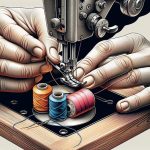Learning to sew is like learning any new skill; it requires patience, practice, and perseverance. But how hard is it, really? As someone who once grappled with tangled threads and uneven stitches, I can attest to the frustrations that come with mastering this craft.
However, the sense of accomplishment that follows a completed project is unparalleled. So, before you toss in the bobbin, let's explore the journey from threading a needle to creating your own custom wardrobe.
Table of Contents
Key Takeaways
- Learning to sew is manageable with patience and practice.
- Mastering basic sewing techniques is essential for beginners.
- Choosing the right fabric and tools is crucial for success.
- Understanding sewing machine basics enhances efficiency and quality.
Benefits of Learning to Sew
Learning to sew offers a multitude of benefits that can enhance both creativity and practical skills. One significant advantage is the opportunity to express oneself through a creative outlet. Sewing allows me to bring my unique ideas to life, whether it's designing a new garment or adding personal touches to existing items. This process not only boosts my creativity but also serves as a stress relief from the demands of daily life. The rhythmic motion of stitching can be meditative and calming, providing a welcome escape from the hustle and bustle.
Additionally, sewing is a cost-effective way to explore fashion and style. By learning to create and repair clothing, I can save money on buying new items and instead, upcycle old pieces into fresh, trendy looks. This approach not only benefits my wallet but also promotes sustainable fashion practices by reducing waste and supporting eco-friendly choices. Learning to sew opens up a world of possibilities for both my wardrobe and the environment.
Essential Sewing Supplies for Beginners
Exploring sewing as a beginner requires gathering essential supplies that lay the foundation for your creative journey. When it comes to fabric selection, opt for easy-to-sew fabrics like cotton or linen to start. These materials are critical and ideal for practicing basic stitches.
Next, investing in sewing tool essentials is essential. A good pair of fabric scissors, pins, a seam ripper, measuring tape, and a variety of hand sewing needles are must-haves. These tools will aid in cutting fabric accurately, securing pieces together, fixing mistakes, and ensuring proper measurements for your projects.
Additionally, owning a reliable sewing machine simplifies the stitching process and opens up a world of possibilities. As a beginner, focus on mastering the basics with these fundamental supplies before delving into more advanced techniques. Remember, having the right tools at your disposal can make the learning process smoother and more enjoyable.
Basic Sewing Techniques to Master
When starting to sew, mastering essential stitches is key to creating beautiful projects. Understanding how to choose the right fabric for your creations can make a significant difference in the final outcome.
Learning the basics of operating a sewing machine is essential for efficiency and precision in your sewing projects.
Essential Stitches for Beginners
Mastering a few essential stitches is the key to building confidence and creating beautiful sewing projects as a beginner. When starting out, mastering straight stitches, backstitches, and running stitches will lay a solid foundation for your sewing journey.
Straight stitches are fundamental for joining fabric pieces together, while backstitches provide strength and durability to your seams. Running stitches are versatile and can be used for gathering fabric or creating decorative designs.
These basic stitching techniques are the building blocks for more advanced sewing projects. By practicing these stitches, you'll gain the skills needed to tackle a variety of sewing tasks and enhance your creativity in crafting unique pieces.
Choosing Right Fabric
Have you ever wondered how to choose the right fabric for your sewing projects? When it comes to fabric selection, understanding color theory can make a significant difference in the outcome of your creations. Here are some key points to ponder:
- Fabric Type: Each fabric type behaves differently; ponder factors such as drape, stretch, and weight.
- Color Matching: Use color theory principles to choose complementary or contrasting colors for your projects.
- Print Scale: Pay attention to the scale of prints concerning the size of your project for a balanced look.
- Fabric Care: Check the care instructions to ponder your final piece can be maintained properly.
Sewing Machine Basics
Exploring the fundamental sewing machine basics is essential for beginners to kickstart their journey into the world of sewing. Understanding thread tension and machine troubleshooting can make a significant difference in the quality of your stitches.
When starting, it's important to grasp the different needle types available and how they impact various fabrics. Choosing the right needle can prevent fabric damage and guarantee smooth sewing.
Additionally, mastering stitch length is key; different projects may require adjustments to achieve the desired outcome. Stay patient and experiment with scrap fabric to understand how stitch length affects the overall look of your project.
Common Challenges When Learning to Sew
When starting to learn how to sew, beginners often encounter several common challenges that can be both frustrating and discouraging. Here are some of the typical hurdles you might face:
- Mastering Sewing Techniques: Understanding different stitches, seams, and finishes can be overwhelming at first. It requires patience and practice to perfect these techniques.
- Identifying Sewing Mistakes: Recognizing where you went wrong in a project is essential. Whether it's a crooked seam or a tension issue, learning to pinpoint mistakes is vital for improvement.
- Troubleshooting: When things go awry, knowing how to troubleshoot problems like jammed threads or skipped stitches can be tricky but is an important skill to develop.
- Problem Solving: Sewing often involves problem-solving, such as figuring out why a pattern doesn't fit correctly or how to alter it to suit your needs. This critical thinking aspect is key to advancing your sewing abilities.
Sailing through these challenges is all part of the learning process, and with persistence, you'll soon find yourself overcoming them one stitch at a time.
Tips for Overcoming Sewing Frustrations
Getting through the frustrations of sewing can be challenging, but there are effective strategies that can help you overcome these obstacles and enhance your sewing journey. Patience practice is key when facing sewing frustrations. It's important to remember that mastering sewing skills takes time, and setbacks are part of the learning process. Here are some skill-building strategies to help you navigate through sewing frustrations:
| Skill Building Strategies | Description | Benefits |
|---|---|---|
| Practice Regularly | Consistent practice improves your skills and boosts confidence. | Enhances muscle memory and improves precision. |
| Break Down Projects | Divide complex projects into smaller tasks to avoid feeling overwhelmed. | Makes sewing more manageable and increases focus. |
| Learn from Mistakes | Analyze what went wrong and use it as a learning opportunity. | Helps you grow as a sewer and prevents repeating errors. |
| Seek Guidance | Join sewing communities or take classes to learn from experienced sewers. | Offers support, advice, and new techniques to overcome challenges. |
Resources for Beginner Sewers
For beginners looking to enhance their sewing skills, exploring online tutorials and sewing blogs can provide valuable guidance and inspiration. These resources offer step-by-step instructions and tips from experienced sewers that can help you develop your techniques and grow your confidence.
Here are four essential resources for beginner sewers:
- Sewing Patterns: Utilize beginner-friendly sewing patterns to practice your skills and create garments or projects. Patterns provide a roadmap for your sewing journey and help you understand garment construction.
- Online Tutorials: Watch video tutorials on platforms like YouTube or dedicated sewing websites to learn new techniques, such as inserting zippers or sewing buttonholes. Visual demonstrations can be incredibly helpful in understanding complex sewing processes.
- Sewing Blogs: Follow sewing blogs that resonate with your style and skill level. Bloggers often share personal tips, reviews of sewing tools, and insights into the sewing community, fostering a sense of belonging and motivation.
- Sewing Classes: Consider enrolling in online or in-person sewing classes for hands-on guidance and feedback from instructors. Classes can provide structured learning and opportunities to ask questions in real-time, accelerating your sewing skills development.
Frequently Asked Questions
How Long Does It Typically Take to Become Proficient at Sewing?
Typically, becoming proficient at sewing varies based on the learning curve, time commitment, and practice techniques. Skill progression is gradual, but with dedication, one can see improvement in a few months to a year.
Is It Necessary to Invest in Expensive Sewing Equipment and Machines as a Beginner?
As a beginner, investing in expensive sewing equipment isn't necessary. Budget-friendly alternatives exist. Quality vs. price is important. DIY sewing hacks and creative solutions can help save money while still allowing for skill development and mastery.
Can Sewing Be a Profitable Skill to Learn in Terms of Selling Handmade Items?
Sewing can be profitable with the right pricing strategy and marketing techniques. Utilizing online platforms and participating in craft fairs can increase sales. By understanding customer preferences, one can create sought-after handmade items.
Are There Any Specific Health Risks Associated With Sewing, Such as Repetitive Strain Injuries?
To avoid health risks like repetitive strain injuries when sewing, it's important to take preventive measures. Prioritize ergonomics by ensuring proper posture, adjusting chair height, and taking breaks. These practices can help maintain physical well-being while enjoying sewing.
What Are Some Advanced Sewing Techniques That Beginners Can Aspire to Learn After Mastering the Basics?
Exploring advanced stitching techniques opens up a world of creativity. Fabric manipulation and embellishment techniques elevate projects. From intricate embroidery to precise piping, mastering these skills adds depth and artistry to sewing endeavors.
- How Does Ring Spun Cotton Affect Garment Fit and Shape Retention? - August 13, 2024
- What Are the Challenges in Producing Ring Spun Cotton? - August 13, 2024
- Is Ring Spun Cotton Suitable for Plus-Size Clothing? - August 13, 2024







